SWIFT, WITH AMMUNITION
by Wayne van Zwoll
When, 30 years ago, a small Kansas shop came up with a new bullet, no one could have predicted this!
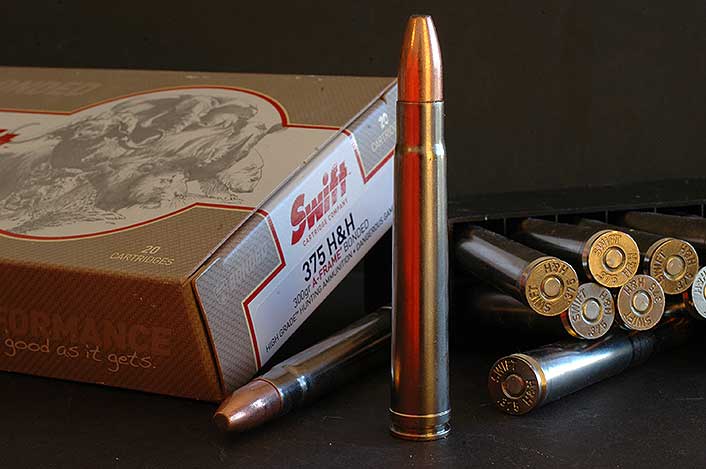
IN 1876 General George A. Custer met his end on bluffs above the Little Bighorn. It was also the model year for Winchester’s first large-frame lever-action rifle. In 1876 Nikolaus Otto developed a four-stroke internal-combustion engine that ran at 180 rotations per minute.
Much has changed in soldiering and rifles since then. Engines too; 35 years ago Honda’s NR500 motorcycle engine was reaching peak “service” horsepower at 19,000 rpms!
Progress in bullets has been less dramatic. Their shape is much the same as when cartridge rifles supplanted muzzle-loaders. Most bullets are still fashioned primarily of lead. But smokeless powder and modern steels have prompted changes. In part to keep bullets from melting as they brook breech pressures over 60,000 psi and launch speeds topping Mach 3, lead cores now get a dash of antimony (commonly 3 percent) and wear jackets of gilding metal (commonly 95 percent copper, 5 percent zinc). To better battle wind and gravity at distance, bullets have become sleeker. Myriad designs and devices have appeared to help hunting bullets carve lethal wound cavities in big game.
In another life, I edited Kansas Wildlife Magazine for the Kansas Fish and Game Commission. While most state wildlife agencies are headquartered in the capitol (Olympia, in my current home state of Washington) or in a major city (Portland, for Oregon’s DF&W), Kansas at that time staffed and ran its wildlife programs from Pratt, a rural town west of center in the state, comfortably distant from Topeka. The reason: Early on, a fish hatchery had sprung up near Pratt. During the agency’s formative years, that site had become by default its main camp. We who’d inherited that office counted ourselves blessed by the location. No one wanted to move east – not even those of us too busy to indulge in the excellent west-side hunting and fishing.
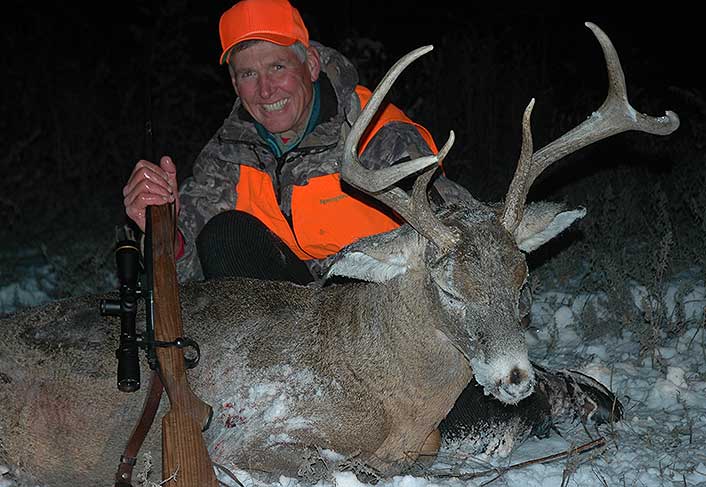
In those days I free-lanced a bit for Rifle magazine. Ever poking around for stories to tell, I came across mention of a small bullet shop in Quinter, a few miles west of Pratt. One weekend I drove there to meet Lee Reed, a young man who’d started the enterprise. It was still new. Quinter wasn’t, but I surmised it hadn’t grown a great deal over the past few decades. Little of it protruded beyond the shadow cast by the central grain elevator. So despite lack of signage, Swift Bullets was easy to find.
In 1982, in the middle of the Big Empty, Lee decided he could make a better big game bullet. He started his company in a dimly lit building little more spacious than a rabbit warren. Crude benches held the tooling: C&H dies in loading presses. Corbin hardware helped him form cores, which he jacketed with .22 rimfire cases. Two years later he was ready to announce a new bullet, one based on two fine hunting designs dating to the 1940s. The German H-Mantle featured a lead core divided by a mid-section dam of jacket material. John Nosler’s similar Partition arrived in 1947 after standard softpoints failed to upend a moose he pummeled repeatedly with his .300 H&H. John’s handmade bullets were a hit with his pals, and soon he “went commercial,” eventually replacing his screw machines with more modern tooling.
Lee Reed figured the Partition, as good as it was, could be improved. In his primitive facility he succeeded in bonding the front part of the core, to reduce fragmenting. His A-Frame retained much more of its nose in penetration tests. The captive heel core didn’t need bonding, saving cost. Reed bought an ad in Shotgun News to announce the A-Frame. When I spotted him in Quinter, he was toting a plastic bucket half full of those bullets across a gravel drive. “It’s our conveyor belt,” he grinned.
Unpretentious and soft-spoken, Lee showed me around Swift Bullets. “It’s not fancy, but we have a wonderful staff. They’re salt-of-the-earth people, mostly from local farms. They know how to work, and they have a natural mechanical bent. We have to solve production problems ourselves, because there’s no one else to call.”
At that time, Lee had just returned from a cross-country trip. “I’d talked with Remington on the phone, told them they needed a bullet for really tough game, a bullet to complement the Core-Lokt. That has been around since 1937. It’s a good bullet. But hunters these days are willing to spend more to get more. They study bullets, dig them from game, weigh them. Magnum cartridges shred bullets when they hit big animals up close. Hunters …. well, I had to show Remington what I had. So I loaded my pickup with pails of A-Frame bullets and drove east.”
Not long thereafter, Remington started loading them.
A decade later Pepsi executive Bill Hober invested in Swift Bullets. The additional capital, with Hober’s marketing expertise, promised a brighter future for the company. But that change would sideline Lee Reed.
The new management promoted the A-Frame to handloaders and to ammunition manufacturers. Eventually Swift bullets would sell in 24 countries. Sako, in Finland, and Norma, in Sweden, would load them in finished cartridges. Meanwhile, Hober, his son Tony and the Swift crew went to work on a new design. The Swift Scirocco bullet appeared in 1999. A bonded lead-core bullet with no mid-section dam, it has a sleeker profile than the A-Frame, and a pointed black polymer tip. “It’s designed to drive deep in big game, like the A-Frame,” Bill told me. “But its higher ballistic coefficient means flatter flight, higher retained energy at distance.”
My first experience with the Scirocco came in Alaska, where foul weather delayed the bush plane scheduled to retrieve us from a remote caribou camp. Daily, rain pummeled our tents. We’d run short of food, scrounging blueberries from the tundra and rationing our pancake mix.
The grizzly bear that appeared on a hill early one morning was a welcome diversion to the fellow who had a tag for same. Three of us set off on a long sneak. Half an hour later, the hunter loosed a bullet from his new .300 Remington Ultra Mag. From 80 yards it struck a bit off the mark, upsetting the bear, which spun about with a roar, then hurled itself toward thick cover. Two rifles bellowed, and the grizzly somersaulted. Both bullets were Sciroccos. As we were quite hungry, I volunteered to filet the bruin’s backstraps. “It’s been scavenging caribou,” protested my pal. But the steaks came off anyway. I floured them, peppered them, then seared them in a hot skillet. Verily, I’ve never eaten better bear, or game meat more closely approaching that of elk and bighorn. It was tender, juicy and mild-flavored. Everyone must have shared my enthusiasm. All plates emptied fast. No steaks got cold.

Later that week I tested the Scirocco’s penetration and integrity by firing my .30 magnum into successively thicker trees (live, wet spruces). The bullets bored easily through 4-inch, 6-inch, even 8-inch boles, blasting big holes on exit. Paths appeared straight, expansion uniform.
Some seasons on, I hunted deer with the Scirocco. A quartering buck took my .30-06 bullet in the forward ribs. It broke the off shoulder. The animal fell immediately and was quickly dead.
The A-Frame ranks among my favorites bullets for heavy game. It has behaved for me much like the Trophy Bonded design Federal bought from Jack Carter. I get double-diameter mushrooms that weigh very little less than they did in the cartridge. Expansion typically stops mid-shank. How much an intact heel contributes to straight-line penetration, I can’t say; but in my experience bullets that retain a “rudder” are less apt to wander than those that quickly “pancake” or “ball up.” A dam or thick heel jacket or solid heel will typically arrest or retard upset, which affects finished diameter and, like high sectional density at the start, enhances penetration. A-Frame mushrooms look like a mushrooms, and plow broad channels.
In Wyoming hills one October morning, still-hunting down a timbered ridge, I spied a splash of dun in the dark-green conifers. I crept closer, rifle ready. An elk’s shoulder winked in an opening. I sent a 150-grain Swift A-Frame from the .270 Howell. Elk thundered off in two directions. Following the hoof-gashes of the main group, I found no blood. Odd. I bird-dogged the others. Nada. Back where the target animal had stood, I glanced down the steep slope – and spied the elk. The A-Frame had minced its lungs. It had made but a single leap before tumbling down the hill, dead. Skinning, I found the bullet perfectly mushroomed under the off-side hide. Later it would scale 92 percent of starting weight.
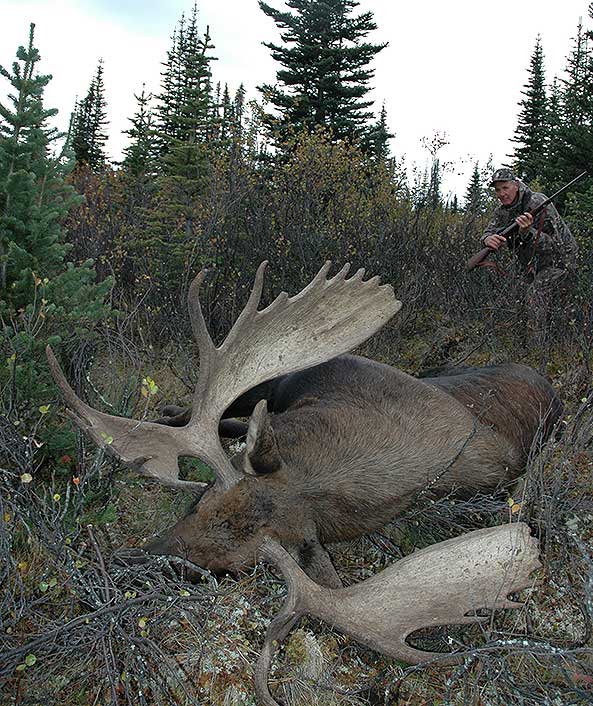
In the crowded field of big game bullets these days, I can’t think of a better choice for elk than the Swift A-Frame. A 250-grain .266 bullet also served me, in a CZ 9.3×62, for moose and mountain goat. The moose fell to one shot at 40 yards. The obstinate billy absorbed two as he quartered off at 240.
Bill Hober and his company haven’t paused in their mission to grow Swift. There’s a Scirocco II now, which Bill claims opens at terminal speeds as low as 1,440 fps. “It still holds up to the tremendous stresses imposed on bullets by high-speed hits on thick bones and muscle.”
Both Scirocco and A-Frame lines boast more offerings, and they’ve been joined by a solid bullet for heavy African game. The Break-Away Solid comes in weights and diameters for the most popular of big-bores, from the 9.3×62 to the .500 Jeffery and .505 Gibbs. It’s a lead-core bullet with a thick jacket of proprietary metal. A short driving band and “rebated” ogive distinguish it – as does the polymer nose that improves feeding but breaks off on impact. The almost-squared-off nose underneath helps keep the bullet on a straight course during penetration.
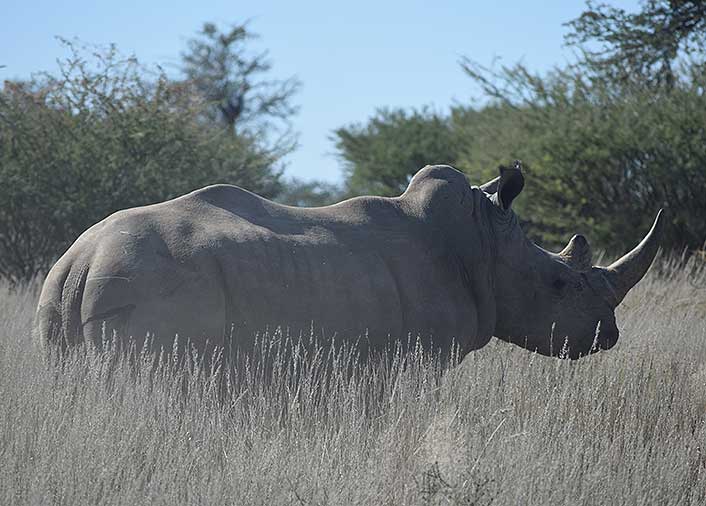
Swift has added hollow-nose A-Frame revolver bullets to its catalog. “They’re designed to open at speeds down to 950 fps,” says Bill Hober, “but stay together at impact three times that violent. Average terminal diameter is 1.65 times the original, with 97 percent weight retention.” Two revolver bullets on the Swift list are also sold with sabots, for muzzle-loading rifles. “The .429 A-Frame for .44 Magnums serves 50-caliber black powder rifles; .452s for the .45 Colt and .454 Casull work in .54 muzzle-loaders.”
Scirocco II bullets, from 62-grain .224s to 210-grain .338s, come in 100-count boxes. A-Frames, from 100-grain .257s to 570-grain .510s, come 50 to a box. Neither is cheap; the A-Frame makes you dig a bit deeper. For example, a box of 150-grain 7mm Sciroccos lists for $63. A box of 140- or 160-grain A-Frames (half as many bullets) costs $57.75. Break-Away Solids are more expensive still, a box of 50 300-grain .375s setting you back $120.50.
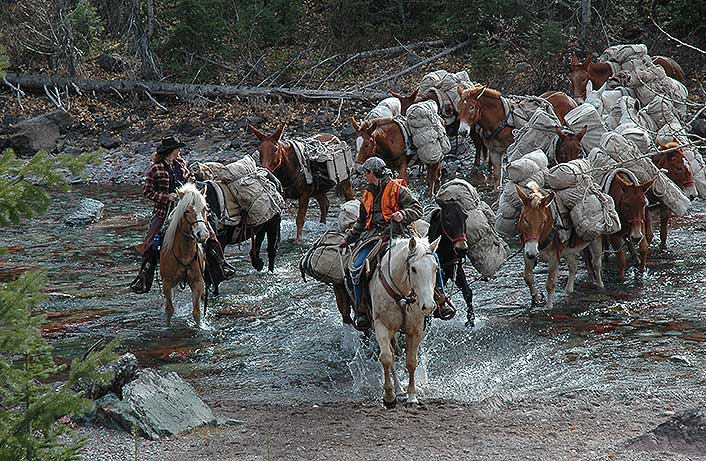
Given Bill’s ambitions for Swift, I wasn’t surprised when, not long ago, I found just outside the shadow of Quinter’s grain elevator, a sparkling new bullet-making facility. In space, sophistication and, well, eye appeal, it had nothing in common with the original Swift digs – which had, in fairness, grown to accommodate the expanding product lines and climbing sales volumes. “We’re not stopping with bullets,” Hober confided during that preview. “We’re well on the way to making ammunition.”
This year you can buy Swift-manufactured ammunition in a half-dozen designated series. Some offerings on the lists have yet to come off the line at this writing, but the most common chamberings are at market. The series: Scirocco II, A-Frame, Lever-Action, A-Frame Heavy Rifle, Break-Away Solid and Heavy Revolver. You’ll find cartridge cases nickel-plated for Heavy Rifle/Dangerous Game (A-Frame and Break-Away Solid) and Heavy Revolver loads. Here’s the whole caboodle a glance, cartridges then bullet weights in grains:
Scirocco II
.223 – 75
.243 – 90
.270 – 130
7mm Rem. Mag. – 150
.308 – 150
.30-06 – 180
.300 Win. Mag. – 180
.300 Wby. Mag. – 180
.300 RUM – 180
.338 Win. Mag. – 210
.338 Lapua – 210
A-Frame
.270 – 150
7mm Rem. Mag. – 160
.308 – 165
.30-06 – 180
.300 Win. Mag. – 180
.300 Wby. Mag. – 180
.300 RUM – 200
.338 Win. Mag. – 250
.338 Lapua – 250
Lever-Action (A-Frame, engineered to expand and penetrate at impact velocities 1,200 to 2,700 fps)
.45-70 – 350 A-Frame
A-Frame, Heavy Rifle/Dangerous Game
9.3×62 – 286
.375 H&H – 300
.375 Ruger – 300
.416 Rem. Mag. – 400
.416 Rigby – 400
.404 Jeffery – 400
.458 Win. Mag. – 500
.458 Lott – 500
.470 NE – 500
.505 Gibbs – 570
.500 Jeffery – 570
.500 NE – 570
Break-Away Solid, Heavy Rifle/Dangerous Game
9.3×62 – 286
.375 H&H – 300
.375 Ruger – 300
.416 Rem. Mag. – 400
.416 Rigby – 400
.404 Jeffery – 400
.458 Win. Mag. – 500
.458 Lott – 500
.470 NE – 500
.505 Gibbs – 570
.500 Jeffery – 570
.500 NE – 570
A-Frame, Heavy Revolver (hollow-point A-Frames, designed to expand and penetrate from 950 fps)
.357 Mag. – 180
.41 Mag. – 210
.44 Mag. – 300
.45 Colt – 265
.454 Casull – 300
.460 S&W – 300
.500 S&W – 325
Ammunition comes in 20-round boxes (except .357 revolver loads, 25 to a box). Retail prices for the new Swift ammo are predictably high. For example:
.243 Scirocco – $45.50
.300 Win. Mag. Scirocco – $59.25
.300 Win. Mag. A-Frame – $64.75
.375 H&H Mag. A-Frame – $84.50
.44 Mag. A-Frame – $48.25
On the other hand, whether you pay $1 for a cartridge, or $4 – even if you fire a box of them from hunting positions after zeroing – you won’t notice the ding in your bank account. And ammunition is one of the smallest investments you’ll make in any hunt. A Montana NR deer/elk license now costs $1,000, a basic Ram 4×4 crew-cab half-ton about $35,000. You’ll spend more to fill its tank with $3 gasoline than you’ll pay for a box of Swift cartridges for your 7mm or .300 Magnum. Then there’s camp gear, food, the packer’s fee to haul your elk or moose out of the woods. Any guided hunt bumps total cost like an NFL kicker boots a football.
My wife, Alice, tells me nickels come out of my pocket just a little thinner than most. She’s right. But do I hunt with sub-standard loads to save a few pennies? Not yet.
Wayne van Zwoll has published 16 books and roughly 3,000 magazine articles on firearms and hunting. Five of his most popular books are: Shooter’s Bible Guide to Rifle Ballistics ($20), Shooter’s Bible Guide to Handloading ($20), Mastering Mule Deer ($25), Mastering the Art of Long-Range Shooting ($30) and Gun Digest Shooter’s Guide to Rifles ($20). Limited numbers are available, autographed, from Wayne at 2610 Highland Drive, Bridgeport WA 98813. Please add $4 shipping.
Stay Connected
- Got a Break in the Montana Missouri Breaks
- It Took Six Days but We Finally Slipped One Past the Bears and Wolves
- No Mule Deer This Fall – Whitetail TOAD!
- An Accounting of Four Idaho Bulls (Elk)
- Arizona Deer Hunt 2019: Good Times with Great Guys
- Caught a Hornady 143 ELDX Last Night
- Cookie’s 2019 Mule Deer Photo Run
- Let’s See Some Really Big Deer
- Alaskan Moose Hunt Success!
- Take a Mauser Hunting: An Important Message From The Mauser Rescue Society!
- Welcome 16 Gauge Reloaders! Check In Here.
- Off-Hand Rifle Shooting – EXPERT Advice
- BOWHUNTING: A Wide One!

